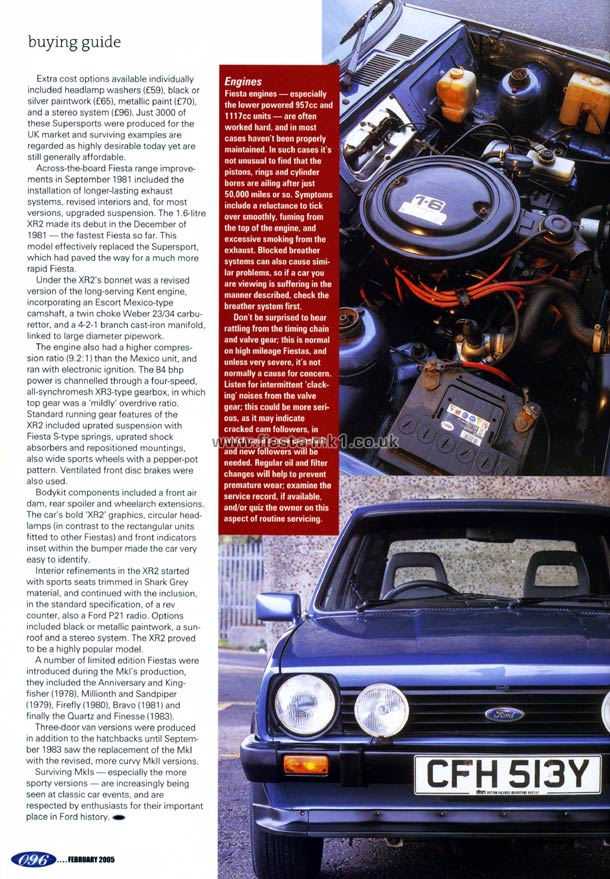Copy of Article Text Below
.....Extra cost options available individually included headlamp washers (£59), black or silver paintwork (£65), metallic paint (£70), and a stereo system (£96). Just 3000 of these Supersports were produced for the UK market and surviving examples are regarded as highly desirable today yet are still generally affordable.
Across-the-board Fiesta range improvements in September 1981 included the installation of longer-lasting exhaust systems, revised interiors and, for most versions, upgraded suspension. The 1.6-litre XR2 made its debut in the December of 1981 - the fastest Fiesta so far. This model effectively replaced the Supersport, which had paved the way for a much more rapid Fiesta.
Under the XR2's bonnet was a revised version of the long-serving Kent engine, incorporating an Escort Mexico-type camshaft, a twin choke Weber 23/34 carburettor, and a 4-2-1 branch cast-iron manifold, linked to large diameter pipework.
The engine also had a higher compression ratio (9.2:1) than the Mexico unit, and ran with electronic ignition. The 84 bhp power is channelled through a four-speed, all-synchromesh XR3-type gearbox, in which top gear was a 'mildly' overdrive ratio. Standard running gear features of the XR2 included uprated suspension with Fiesta S-type springs, uprated shock absorbers and repositioned mountings, also wide sports wheels with a pepper-pot pattern. Ventilated front disc brakes were also used.
Bodykit components included a front air dam, rear spoiler and wheelarch extensions. The car's bold 'XR2' graphics, circular headlamps (in contrast to the rectangular units fitted to other Fiestas) and front indicators inset within the bumper made the car very easy to identify.
Interior refinements in the XR2 started with sports seats trimmed in Shark Grey material, and continued with the inclusion, in the standard specification, of a rev counter, also a Ford P21 radio. Options included black or metallic paintwork, a sunroof and a stereo system. The XR2 proved to be a highly popular model.
A number of limited edition Fiestas were introduced during the Mkl's production, they included the Anniversary and Kingfisher (1978), Millionth and Sandpiper (1979), Firefly (1980), Bravo (1981) and finally the Quartz and Finesse (1983).
Three-door van versions were produced in addition to the hatchbacks until September 1983 saw the replacement of the Mkl with the revised, more curvy Mkll versions.
Surviving Mkls - especially the more sporty versions - are increasingly being seen at classic car events, and are respected by enthusiasts for their important place in Ford history.
Engines
Fiesta engines - especially - the lower powered 957cc and 1117cc units - are often worked hard, and in most cases haven't been properly maintained. In such cases it's not unusual to find that the pistons, rings and cylinder bores are ailing after just 50,000 miles or so. Symptoms include a reluctance to tick over smoothly, fuming fr the top of the engine, and excessive smoking from the exhaust. Blocked breather systems can also cause similar problems, so if a car you are viewing is suffering in the manner described, check the breather system first.
Don't be surprised to hear riittliny from the timing chain and valve gear; this is normal on high mileage Fiestas, and unless very severe, it's not normally a cause for concern. Listen for intermittent 'clacking' noises from the valve gear; this could be more serious, as it may indicate cracked cam followers, in which case a new camshaft and new followers will be needed. Regular oil and filter changes will help to prevent premature wear; examine the service record, if available, and/or quiz the owner on this aspect of routine servicing.
|








